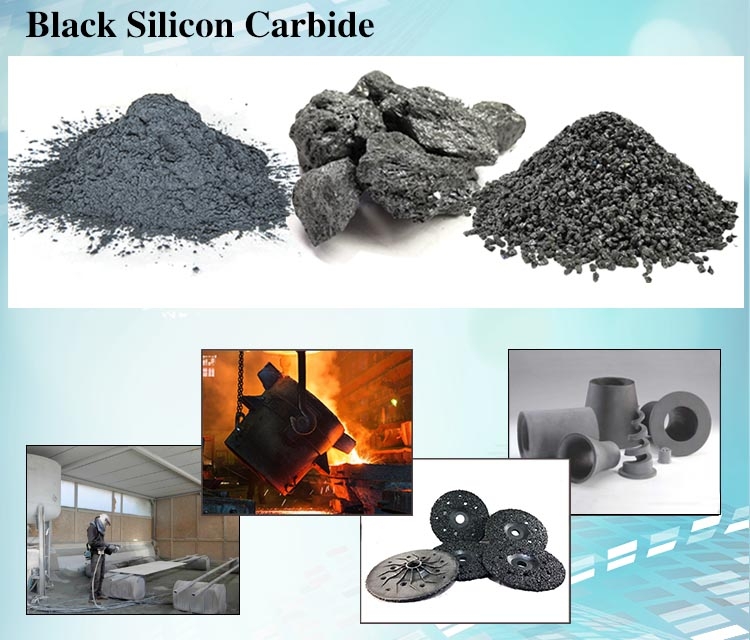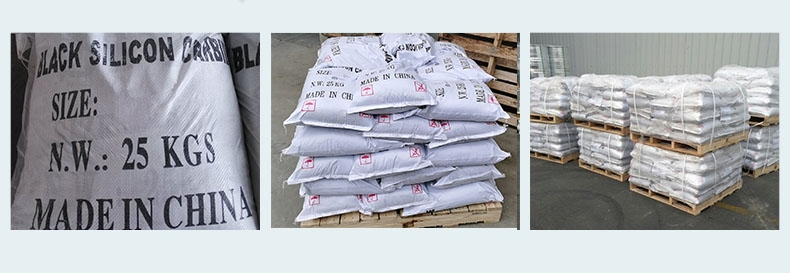Silicon Carbide is produced by a process involving the electrochemical reaction of silica(SiO2)-in the form of quartz mixed with Carbon(C) in the form of raw petroleum coke. The stoichiometric mixture is reacted in an electrical resistance furnace at a temperature up to 2500 centigrade to yield high-quality crystals. The process is large furnace technology with a graphite electrode in the furnace center. The large crystals are then segregated, crushed, cleaned of magnetic impurities in high-intensity magnetic separators, and classified into narrow size fractions to suit the end-use.
| TYPICAL CHEMICAL ANALYSIS | TYPICAL PHISICAL PROPERTIES | ||
| SiC | ≥98% | Hardness: | Mohs:9.15 |
| SiO2 | ≤1% | Melting Point: | Sublimes at 2250 ℃ |
| H2O3 | ≤0.5% | Maximum service temperature: | 1900℃ |
| Fe2O3 | ≤0.3% | Specific Gravity: | 3.2-3.45 g/cm3 |
| F.C | ≤0.3% | Bulk density(LPD): | 1.2-1.6 g/cm3 |
| Magnetic content | ≤0.02% | Color: | Black |
| Particle shape: | Hexagonal | ||
Black silicon carbide micropowder JIS grit particle size distribution.
| JIS Grit Size | D0(Micron) | D3(Micron) | D50(Micron) | D94(Micron) |
| #240 | ≤ 127 | ≤ 103 | 57.0±3.0 | ≥ 40 |
| #280 | ≤ 112 | ≤ 87 | 48.0±3.0 | ≥ 33 |
| #320 | ≤ 98 | ≤ 74 | 40.0±2.5 | ≥ 27 |
| #360 | ≤ 86 | ≤ 66 | 35.0±2.0 | ≥ 23 |
| #400 | ≤ 75 | ≤ 58 | 30.0±2.0 | ≥ 20 |
| #500 | ≤ 63 | ≤ 50 | 25.0±2.0 | ≥ 16 |
| #600 | ≤ 53 | ≤ 41 | 20.0±1.5 | ≥ 13 |
| #700 | ≤ 45 | ≤ 37 | 17.0±1.5 | ≥ 11 |
| #800 | ≤ 38 | ≤ 31 | 14.0±1.0 | ≥ 9.0 |
| #1000 | ≤ 32 | ≤ 27 | 11.5.±1.0 | ≥ 7.0 |
| #1200 | ≤ 27 | ≤ 23 | 9.5±0.8 | ≥ 5.5 |
| #1500 | ≤ 23 | ≤ 20 | 8.0±0.6 | ≥ 4.5 |
| #2000 | ≤ 19 | ≤ 17 | 6.7±0.6 | ≥ 4.0 |
| #2500 | ≤ 16 | ≤ 14 | 5.5±0.5 | ≥ 3.0 |
| #3000 | ≤ 13 | ≤ 11 | 4.0±0.5 | ≥ 2.0 |
| #4000 | ≤ 11 | ≤ 8.0 | 3.0±0.4 | ≥ 1.8 |

